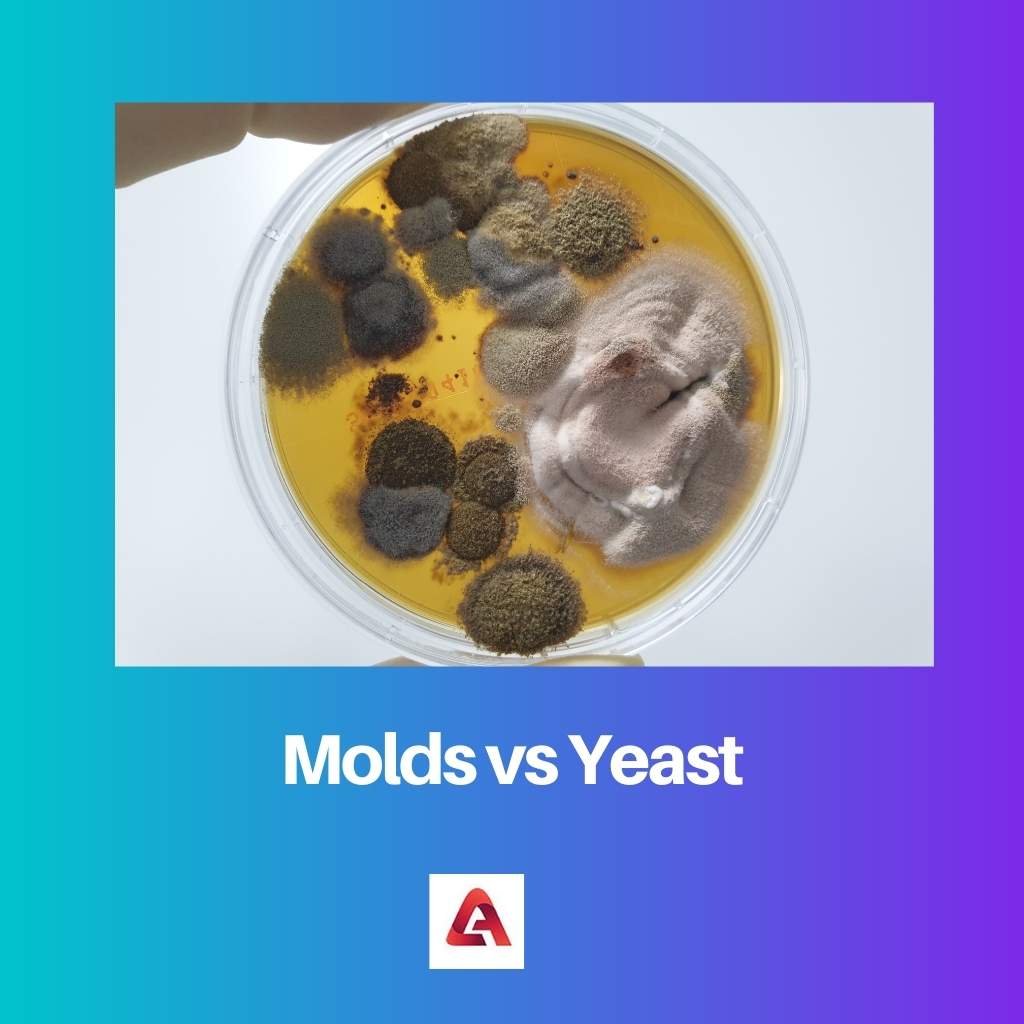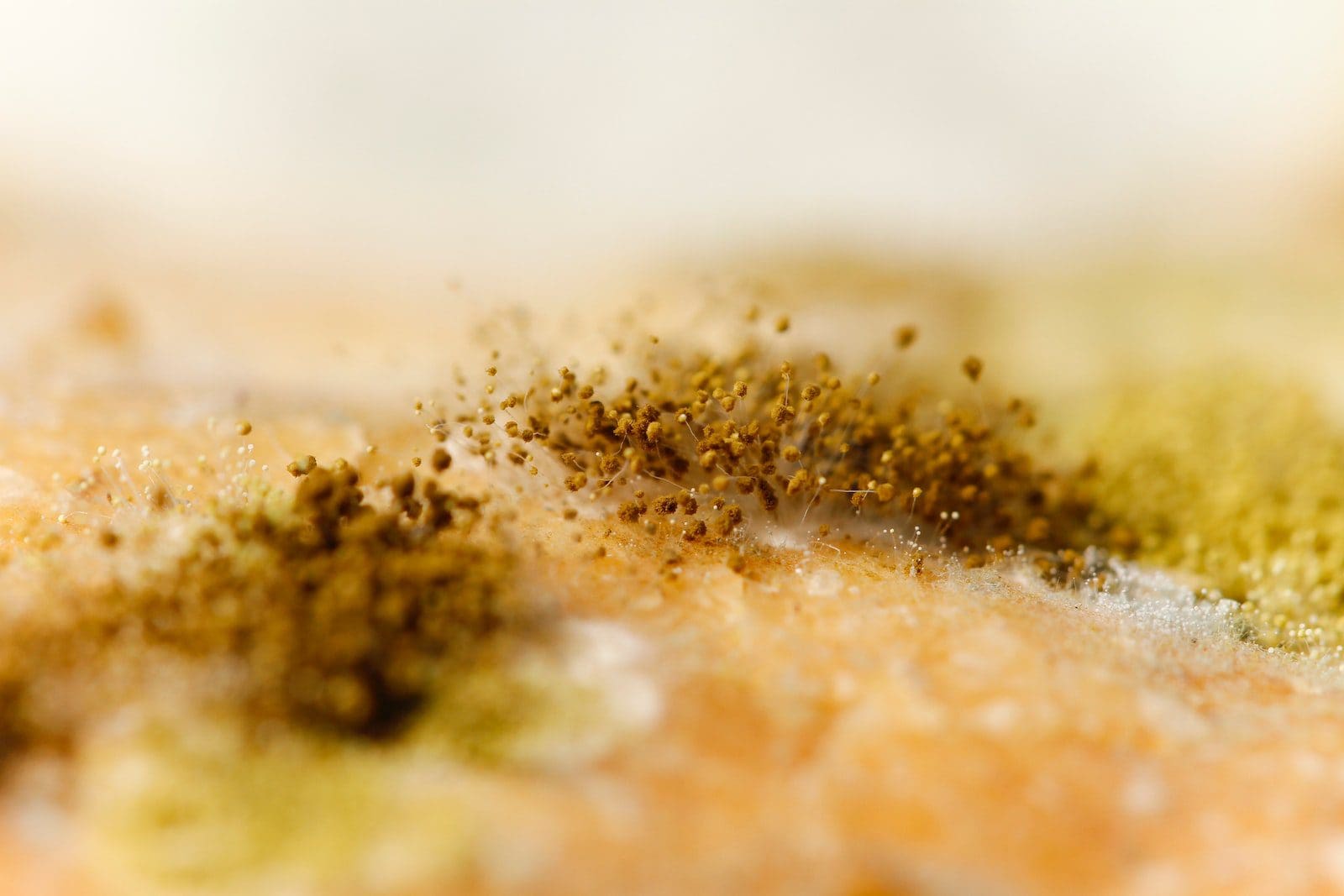Fungi are eukaryotic complex multicellular organisms. They have filaments which are termed hyphae. The fungal cell wall consists of glucans, chitin, and glycoproteins. The mode of reproduction is spore formation.
They can survive in diverse habitats. The various microorganisms under fungi are molds, yeast, rusts, smuts, mildews, and many others.
Key Takeaways
- Molds are multicellular fungi that grow in thread-like structures called hyphae, whereas yeast is single-celled fungi.
- Molds reproduce through spores, while yeast reproduces through budding or fission.
- Molds can cause food spoilage and produce mycotoxins, while yeast is beneficial in food production, such as bread and beer.
Molds vs Yeast
Molds are multicellular fungi that grow in the form of hyphae, which are thread-like structures that can spread out and form large colonies. They are commonly found in damp environments. Yeast is a single-celled fungus that is used in the production of food and beverages, including bread, beer, and wine. Yeast cells reproduce by budding, which involves the growth of a new cell from the parent cell.

Molds are found in damp and dark areas which have no sunlight and ventilation. It survives on a heterotrophic mode of nutrition.
It is the main reason for food spoilage and hence is widely used in the food technology industry, biotechnology, pharmaceutical, and beverage (alcoholic and non-alcoholic) production units.
While yeast is found on the skin of vegetables, fruits, and other living beings, it is even found between the toes of humans and in the gut of several creatures. It survives on the chemoorganotrophic mode of nutrition.
It is widely used in fermentation, baking, brewing, and beverage production and can even generate electricity.
Comparison Table
| Parameters of Comparison | Molds | Yeast |
|---|---|---|
| Type of cells | Multicellular | Unicellular |
| Mode of nutrition | Heterotrophy, which means that they survive on organic matter | Chemoorganotrophs, that is they depend on organic compounds for growth and survival |
| Mode of reproduction | Spore formation | Fission Or budding |
| Viable environmental conditions | Found in damp, dark places with no sunlight and ventilation | Found on the skin of fruits, vegetables, the skin of several mammals, and in the gut of many living beings |
| Uses | Biotechnology, food science, antibiotics, pharmaceutical, and beverage industry | Fermentation, baking, beverage production industry, generate electricity through microbial fuel cells and play a significant role in the biofuel industry by producing ethanol. |
What are Molds?
Molds (or singular Mould), are a member of the fungal kingdom. The growth of molds is observed as multicellular filaments, which are termed hyphae. The hyphae provide a fuzzy, fine white thread-like appearance.
Molds follow asexual spore formation for reproduction, and these spores are called conidia. Molds have thousands of species that may or may not be toxic to other living beings.
Molds follow heterotrophy, which means that they survive on organic matter. The hyphal tips of molds secrete hydrolytic enzymes, which can degrade biopolymers like starch, lignin, cellulose, and other complex substances.
The decomposition property of molds helps nutrients recycle within the ecosystem.
Molds can be commonly found causing food spoilage. This biodegradation characteristic of molds has paved a significant role in biotechnology, food science, antibiotics, pharmaceutical, and beverage industry. The discovery of Penicillin serves as a benchmark for molds in the pharmaceutical industry. Some molds are also toxic, called mycotoxins, and can cause numerous diseases.
Molds can remain alive in a dormant stage under extreme conditions. Molds can grow in household areas that are damp, porous, and receive no sunlight and ventilation. Interior mold colonization can cause severe health problems.
Molds have also been incorporated in art and culture exhibitions like the macro-micro portrait created by Stacy Levy.

What is Yeast?
Yeasts are eukaryotic unicellular microorganisms and a type of fungal species. Yeast had over 1500 species. It undergoes budding or fission as the mode of reproduction.
These buds are termed pseudohyphae. Yeasts are called chemoorganotrophs, that is, they depend on organic compounds for growth and survival.
Yeast plays a crucial part in the fermentation, baking, and beverage production industry. Yeast has been a creator of bread, wine, and beer in history. Yeast can also generate electricity through microbial fuel cells.
They play a significant role in the biofuel industry by producing ethanol. Some yeast is toxic and can cause various infections in living beings.
Yeast can grow in a neutral and slightly acidic pH environment. The yeast cells are elongated and circular or ovoid-shaped. Yeast is found on the human skin and guts of several mammals and insects. Yeast also has strains called yeast killer toxins which help treat other yeast infections.
Apart from the beverage and baking industry, yeast has a pivotal role in the preparation of probiotic supplements, the generation of carbon dioxide in an aquarium, as food additives and flavours, in preparation of several non-alcoholic beverages, bioremediation, and in the preparation of various vaccines.

Main Differences Between Molds and Yeast
- Molds are multicellular microorganisms that reproduce by spore formation, while yeast is a unicellular microorganism that reproduces by bud formation or fission.
- Molds are colorful and form a filamentous structure called hyphae, and the entire network is called mycelium, while yeast is mostly colorless, has pseudohyphae, and lives in colonies.
- Molds can produce enzymes that can break down biopolymers into simple substances, while yeasts help in fermentation, baking, and beverage production by fermenting carbon-based products and releasing carbon dioxide.
- Molds are heterotrophs and are found in damp, dark places with little or no sunlight and ventilation while yeast is a chemoorganotroph and can survive on the skin of fruits, vegetables, and living beings with neutral or slightly acidic pH.
- Molds can cause various respiratory problems and allergic reactions, while yeast can cause various infections in living beings and creatures.

- https://link.springer.com/content/pdf/10.1007/BF02050743.pdf
- https://www.nature.com/articles/ja2016121

23 Comments
Elizabeth50 · August 20, 2020 at 10:50 am
The detailed descriptions of molds and yeast in this article provide a comprehensive understanding of these eukaryotic organisms. It’s impressive to see the significant roles they play in different industries.
Knight Muhammad · December 30, 2020 at 8:18 am
I couldn’t agree more, Elizabeth50. This article offers valuable insights into the characteristics and applications of molds and yeast.
Palmer Bruce · September 8, 2020 at 9:08 pm
Thank you for this detailed comparison of molds and yeast! It’s fascinating to learn about their differences in terms of nutrition, reproduction, and environmental conditions.
Yreynolds · August 28, 2022 at 6:59 am
I agree, Palmer! This article is very informative and provides a clear understanding of the characteristics of molds and yeast.
Carole Rose · September 25, 2021 at 10:19 pm
This article presents a detailed and thorough examination of molds and yeast, providing a comprehensive understanding of their biological features and applications. It’s an enlightening read.
Powell Frank · December 2, 2021 at 11:28 pm
The thorough comparison of molds and yeast, along with their uses in different industries, offers a comprehensive understanding of these eukaryotic organisms. It’s an enlightening read.
Qkelly · April 20, 2022 at 12:57 pm
I completely agree, Powell Frank. This article presents a detailed examination of molds and yeast, shedding light on their roles in various industrial applications.
Ngraham · October 2, 2022 at 5:41 am
The comparison table is very well-organized and makes it easy to grasp the distinctions between molds and yeast. It’s interesting to see how their uses differ as well.
Ava Wilkinson · May 27, 2023 at 12:18 pm
I completely agree, Ngraham. The table provides a concise overview of the key differences between molds and yeast.
Taylor Donna · July 22, 2023 at 4:18 pm
Absolutely, Ngraham. The uses of molds and yeast in various industries are quite intriguing, and this article does an excellent job of highlighting those differences.
Davis Riley · March 29, 2023 at 7:05 pm
The explanations of molds and yeast, along with their respective growth conditions and uses, are very well-presented in this article. It’s an excellent resource for understanding these organisms.
Frose · August 25, 2023 at 9:26 am
I share the same sentiment, Davis Riley. This article provides a comprehensive overview of molds and yeast, shedding light on their significance in various industries.
Andrew66 · April 26, 2023 at 3:44 pm
The detailed descriptions of molds and yeast, along with a comparison of their nutritional modes, reproduction, and viable environmental conditions, are very informative. It’s an excellent piece of content.
Carmen Lloyd · August 7, 2023 at 5:17 pm
Absolutely, Andrew66. The article provides a comprehensive analysis of molds and yeast, elucidating their distinct characteristics and industrial uses.
Akhan · January 28, 2024 at 1:01 am
I share the same sentiment, Andrew66. The article offers an insightful comparison of molds and yeast, highlighting their unique features and applications.
Robertson Stephen · July 22, 2023 at 3:44 am
The comprehensive overview of molds and yeast, including their characteristics, nutritional modes, and applications, makes this article a valuable source of information. It’s an insightful piece.
Bell Ray · December 31, 2023 at 8:02 pm
I concur, Robertson Stephen. The article provides a detailed analysis of molds and yeast, offering in-depth insights into their biological features and uses.
Mrichardson · November 3, 2023 at 5:29 am
The in-depth analysis of molds and yeast, along with a comparison of their uses in different industries, makes this article a valuable source of information. It’s an insightful piece.
Bgraham · November 15, 2023 at 10:19 pm
I agree, Mrichardson. The article offers a comprehensive overview of molds and yeast, shedding light on their distinct characteristics and roles in different industrial sectors.
Stewart Martin · December 25, 2023 at 12:30 am
Well said, Mrichardson. The detailed descriptions of molds and yeast help clarify their differences and significance in various industries.
David41 · November 21, 2023 at 9:25 pm
The comparisons between molds and yeast, particularly in terms of their mode of nutrition, reproduction, and viable environmental conditions, are thoroughly explained in this article. It’s an enlightening read.
Greid · January 6, 2024 at 2:30 pm
Well said, David41. The article offers a thorough analysis of molds and yeast, emphasizing their distinct characteristics and applications.
Jane Powell · January 9, 2024 at 1:54 pm
I couldn’t agree more, David41. The detailed descriptions of molds and yeast help clarify their differences and roles in different industries.